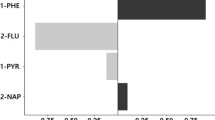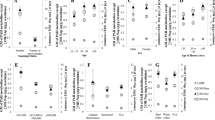Abstract
Occupational polycyclic aromatic hydrocarbons (PAHs) exposure has been shown to increase the risk of various cancers and may be associated with carcinogenic mortality. However, no study has explored the relationship between environmental PAH exposure and mortality in general population. The aim of our study was to explore the association between PAH exposure and all-cause, cardiovascular, and cancer mortality in a general US adult population. We analyzed data from the National Health and Nutrition Examination Survey (NHANES 2001–2006) based on the information in this dataset on 692 males and 717 females. PAH exposure was detected using biomarkers from urine samples. Follow-up data on mortality were derived from initial examination of the subjects until death or 31 December 2006 in the NHANES database. We calculated hazard ratios (HRs) of PAH metabolites among all-cause, cardiovascular, and cancer mortality using the multivariate Cox proportional hazards regression model after adjusting for covariates. Among males, 3-phenanthrene was positively associated with increased risk of all-cause mortality (HR 1.043, 95%CI 1.019–1.066). Female participants with higher 2-napthol (HR 1.043, 95%CI 1.014–1.072), 3-fluorene (HR 2.159, 95%CI 1.233–3.779), and 1-phenanthrene (HR = 1.259, 95%CI 1.070–1.481) levels had increased all-cause mortality. In addition, high 3-phenanthrene (HR 1.333, 95%CI 1.008–1.763) and 1-phenanthrene (HR 1.463, 95%CI 1.126–1.900) levels increased the risk of cardiovascular mortality. However, there were no significant findings for cancer mortality in both genders. Environmental PAH exposure among the adult population is associated with non-carcinogenic but not cancer mortality. Future studies are warranted to determine the underlying mechanisms related to these findings.
Similar content being viewed by others
References
Abdel-Shafy, H. I., & Mansour, M. S. M. (2016). A review on polycyclic aromatic hydrocarbons: Source, environmental impact, effect on human health and remediation. Egyptian Journal of Petroleum, 25, 107–123.
Alhamdow, A., Lindh, C., Albin, M., Gustavsson, P., Tinnerberg, H., & Broberg, K. (2017). Early markers of cardiovascular disease are associated with occupational exposure to polycyclic aromatic hydrocarbons. Scientific Reports, 7, 9426.
Alshaarawy, O., Elbaz, H. A., & Andrew, M. E. (2016). The association of urinary polycyclic aromatic hydrocarbon biomarkers and cardiovascular disease in the US population. Environment International, 89–90, 174–178.
Alshaarawy, O., Zhu, M., Ducatman, A., Conway, B., & Andrew, M. E. (2013). Polycyclic aromatic hydrocarbon biomarkers and serum markers of inflammation. A positive association that is more evident in men. Environmental Resistance, 126, 98–104.
Alshaarawy, O., Zhu, M., Ducatman, A. M., Conway, B., & Andrew, M. E. (2014). Urinary polycyclic aromatic hydrocarbon biomarkers and diabetes mellitus. Occupational and Environmental Medicine, 71, 437–441.
ATSDR. (1995). Toxicological profile for polycyclic aromatic hydrocarbons. Atlanta: Agency for Toxic Substances and Disease Registry.
Baek, S. O., Field, R. A., Goldstone, M. E., Kirk, P. W., Lester, J. N., & Perry, R. (1991). A review of atmospheric polycyclic aromatic hydrocarbons: Sources, fate and behavior. Water, Air, and Soil pollution, 60, 279–300.
Blaak, E. (2001). Gender differences in fat metabolism. Current Opinion in Clinical Nutrition and Metabolic Care, 4, 499–502.
Boffetta, P., Jourenkova, N., & Gustavsson, P. (1997). Cancer risk from occupational and environmental exposure to polycyclic aromatic hydrocarbons. Cancer Causes and Control, 8, 444–472.
Bonvallot, V., Baeza-Squiban, A., Baulig, A., Brulant, S., Boland, S., Muzeau, F., et al. (2001). Organic compounds from diesel exhaust particles elicit a proinflammatory response in human airway epithelial cells and induce cytochrome p450 1A1 expression. American Journal of Respiratory Cell and Molecular Biology, 25, 515–521.
Bosetti, C., Boffetta, P., & La Vecchia, C. (2007). Occupational exposures to polycyclic aromatic hydrocarbons, and respiratory and urinary tract cancers: A quantitative review to 2005. Annals of Oncology, 18, 431–446.
Brucker, N., Charao, M. F., Moro, A. M., Ferrari, P., Bubols, G., Sauer, E., et al. (2014). Atherosclerotic process in taxi drivers occupationally exposed to air pollution and co-morbidities. Environmental Research, 131, 31–38.
Burstyn, I., Boffetta, P., Heederik, D., Partanen, T., Kromhout, H., Svane, O., et al. (2003). Mortality from obstructive lung diseases and exposure to polycyclic aromatic hydrocarbons among asphalt workers. American Journal of Epidemiology, 158(5), 468–478.
Burstyn, I., Kromhout, H., Partanen, T., Svane, O., Langård, S., Ahrens, W., et al. (2005). Polycyclic aromatic hydrocarbons and fatal ischemic heart disease. Epidemiology, 1, 744–750.
(CDC), CFDCAP. (2012). National health and examination survey. Data documentation, codebook, and frequencies. Phthalates, Phytoestrogens, & PAHs–Urine.
Choi, H. H. R., & Komulainen, H. (2010). Polycyclic aromatic hydrocarbon. Geniva: World Health Organization.
Diggs, D. L., Huderson, A. C., Harris, K. L., Myers, J. N., Banks, L. D., Rekhadevi, P. V., et al. (2011). Polycyclic aromatic hydrocarbons and digestive tract cancers—A perspective. Journal of Environmental Science and Health, Part C: Environmental Carcinogenesis & Ecotoxicology Reviews, 29, 324–357.
Harvey, R. G. (1996). Mechanisms of carcinogenesis of polycyclic aromatic hydrocarbons. Polycyclic Aromatic Compounds, 9, 1–23.
Hu, C., Hou, J., Zhou, Y., Sun, H., Yin, W., Zhang, Y., et al. (2018). Association of polycyclic aromatic hydrocarbons exposure with atherosclerotic cardiovascular disease risk: A role of mean platelet volume or club cell secretory protein. Environmental Pollution, 233, 45–53.
Hygienists, A. C. O. G. I. (2005). Polycyclic aromatic hydrocarbons (PAHs) biologic exposure indices (BEI) Cincinnati. In OH: American conference of governmental industrial hygienists.
Jongeneelen, F. J. (2001). Benchmark guideline for urinary 1-hydroxypyrene as biomarker of occupational exposure to polycyclic aromatic hydrocarbons. The Annals of Occupational Hygiene, 45, 3–13.
Jung, K. H., Perzanowski, M., Rundle, A., Moors, K., Yan, B., Chillrud, S. N., et al. (2014). Polycyclic aromatic hydrocarbon exposure, obesity and childhood asthma in an urban cohort. Environmental Research, 128, 35–41.
Kim, K. H., Jahan, S. A., Kabir, E., & Brown, R. J. (2013). A review of airborne polycyclic aromatic hydrocarbons (PAHs) and their human health effects. Environment International, 60, 71–80.
Knaapen, A. M., Curfs, D. M., Pachen, D. M., Gottschalk, R. W., De Winther, M. P., Daemen, M. J., et al. (2007). The environmental carcinogen benzo[a]pyrene induces expression of monocyte-chemoattractant protein-1 in vascular tissue: a possible role in atherogenesis. Mutation Research, 621, 31–41.
Korashy, H. M., & El-Kadi, A. O. (2006). The role of aryl hydrocarbon receptor in the pathogenesis of cardiovascular diseases. Drug Metabolism Reviews, 38, 411–450.
Koster, A., Caserotti, P., Patel, K. V., Matthews, C. E., Berrigan, D., Van Domelen, D. R., et al. (2012). Association of sedentary time with mortality independent of moderate to vigorous physical activity. PLoS ONE, 7, e37696.
Li, J., Zhu, X., Yu, K., Jiang, H., Zhang, Y., Wang, B., et al. (2018). Exposure to polycyclic aromatic hydrocarbons and accelerated DNA methylation aging. Environmental Health Perspectives, 126, 067005.
Mcclean, M. D., Rinehart, R. D., Ngo, L., Eisen, E. A., Kelsey, K. T., Wiencke, J. K., et al. (2004). Urinary 1-hydroxypyrene and polycyclic aromatic hydrocarbon exposure among asphalt paving workers. The Annals of Occupational Hygiene, 48, 565–578.
Miller, B. G., Doust, E., Cherrie, J. W., & Hurley, J. F. (2013). Lung cancer mortality and exposure to polycyclic aromatic hydrocarbons in British coke oven workers. BMC Public Health, 13, 962.
Motorykin, O., Matzke, M. M., Waters, K. M., & Massey Simonich, S. L. (2013). Association of carcinogenic polycyclic aromatic hydrocarbon emissions and smoking with lung cancer mortality rates on a global scale. Environmental Science and Technology, 47, 3410–3416.
Nel, A. E., Diaz-Sanchez, D., & Li, N. (2001). The role of particulate pollutants in pulmonary inflammation and asthma: evidence for the involvement of organic chemicals and oxidative stress. Current Opinion in Pulmonary Medicine, 7, 20–26.
Nel, A. E., Diaz-Sanchez, D., Ng, D., Hiura, T., & Saxon, A. (1998). Enhancement of allergic inflammation by the interaction between diesel exhaust particles and the immune system. The Journal of Allergy and Clinical Immunology, 102, 539–554.
Nikolaou, K., Masclet, P., & Mouvier, G. (1984). Sources and chemical reactivity of polynuclear aromatic hydrocarbons in the atmosphere: A critical review. Science of the Total Environment, 32, 103–132.
Olsson, A. C., Fevotte, J., Fletcher, T., Cassidy, A., Mannetje, T., Zaridze, A., et al. (2010). Occupational exposure to polycyclic aromatic hydrocarbons and lung cancer risk: A multicenter study in Europe. Occupational and Environmental Medicine, 67, 98–103.
Poursafa, P., Moosazadeh, M., Abedini, E., Hajizadeh, Y., Mansourian, M., Pourzamani, H., et al. (2017). A systematic review on the effects of polycyclic aromatic hydrocarbons on cardiometabolic impairment. International Journal of Preventive Medicine, 8, 19.
Rajendran, P., Jayakumar, T., Nishigaki, I., Ekambaram, G., Nishigaki, Y., Vetriselvi, J., et al. (2013). Immunomodulatory effect of mangiferin in experimental animals with benzo(a)pyrene-induced lung carcinogenesis. International Journal of Biomedical Science, 9, 68–74.
Sakai, M., Yoshida, D., & Mizusaki, S. (1985). Mutagenicity of polycyclic aromatic hydrocarbons and quinones on Salmonella typhimurium TA97. Mutation Research/Genetic Toxicology, 156, 61–67.
Siddens, L. K., Larkin, A., Krueger, S. K., Bradfield, C. A., Waters, K. M., Tilton, S. C., et al. (2012). Polycyclic aromatic hydrocarbons as skin carcinogens: comparison of benzo [a] pyrene, dibenzo [def, p] chrysene and three environmental mixtures in the FVB/N mouse. Toxicology and Applied Pharmacology, 264(3), 377–386.
Wagner, M., Bolm-Audorff, U., Hegewald, J., Fishta, A., Schlattmann, P., Schmitt, J., et al. (2015). Occupational polycyclic aromatic hydrocarbon exposure and risk of larynx cancer: a systematic review and meta-analysis. Occupational and Environmental Medicine, 72, 226–233.
Young, C., Rushton, L., & With the British Occupational Cancer Burden Study, G. (2012). Occupational cancer in Britain: Skin cancer. British Journal of Cancer, 107, S71–S75.
Zhang, Y., & Tao, S. (2009). Global atmospheric emission inventory of polycyclic aromatic hydrocarbons (PAHs) for 2004. Atmospheric Environment, 43, 812–819.
Author information
Authors and Affiliations
Contributions
YYC contributed to the design of the study, was responsible for the management and retrieval of data, contributed to initial data analysis and interpretation, drafted the initial manuscript. YYC, TWK, CCW, YJC, CJW, CHL, and WLC decided upon the data collection methods. YYC and WLC were also responsible for the data analysis decisions. WLC conceptualized and designed the study, supervised all aspects of the study, critically reviewed and revised the manuscript, and approved the final manuscript as submitted. All authors meet the ICMJE criteria for authorship.
Corresponding author
Ethics declarations
Conflict of interest
The authors declare that they have no conflict of interest.
Additional information
Publisher's Note
Springer Nature remains neutral with regard to jurisdictional claims in published maps and institutional affiliations.
Rights and permissions
About this article
Cite this article
Chen, YY., Kao, TW., Wang, CC. et al. Polycyclic aromatic hydrocarbon metabolites and mortality risk in an adult population. Environ Geochem Health 43, 37–45 (2021). https://doi.org/10.1007/s10653-020-00663-7
Received:
Accepted:
Published:
Issue Date:
DOI: https://doi.org/10.1007/s10653-020-00663-7




